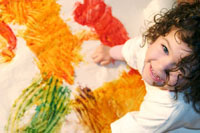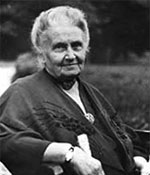 |
"The goal of early childhood education should be to cultivate the child's own natural desire to learn."
– Maria Montessori |
|
 |
What is Montessori?
 In a Montessori classroom children are endlessly exposed to learning through a carefully prepared environment. The children easily flow from area to area absorbing knowledge through the process of their meaningful play. Scrubbing a table, counting spindles, building a tower — all activities in which children are able to gain a better sense of concentration, coordination, and persistence in completing a task. They do these activities for enjoyment, yet indirectly they are developing habits that will later help their academic learning. In a Montessori classroom children are endlessly exposed to learning through a carefully prepared environment. The children easily flow from area to area absorbing knowledge through the process of their meaningful play. Scrubbing a table, counting spindles, building a tower — all activities in which children are able to gain a better sense of concentration, coordination, and persistence in completing a task. They do these activities for enjoyment, yet indirectly they are developing habits that will later help their academic learning.
Who Started Montessori?
 Montessori schools follow a philosophy developed by Dr. Maria Montessori. Born in Italy in 1870, she became Italy's first female doctor. As a physician, she initially took care of children's physical needs and ailments. Her intellectual curiosity led her to an exploration of children's minds and how they learn. After years of observing children, Dr. Montessori discovered environment plays a major factor in child development. Her life long work was then geared toward developing her method of teaching that developed through her scientific observations of the young child's behavior. She discovered that children have an effortless ability to absorb knowledge from their surroundings. "Children teach themselves" became the truth that inspired Montessori's work. Montessori schools follow a philosophy developed by Dr. Maria Montessori. Born in Italy in 1870, she became Italy's first female doctor. As a physician, she initially took care of children's physical needs and ailments. Her intellectual curiosity led her to an exploration of children's minds and how they learn. After years of observing children, Dr. Montessori discovered environment plays a major factor in child development. Her life long work was then geared toward developing her method of teaching that developed through her scientific observations of the young child's behavior. She discovered that children have an effortless ability to absorb knowledge from their surroundings. "Children teach themselves" became the truth that inspired Montessori's work.
|
